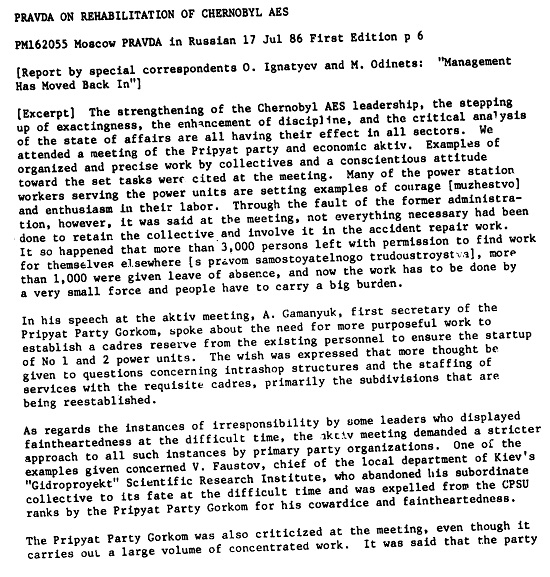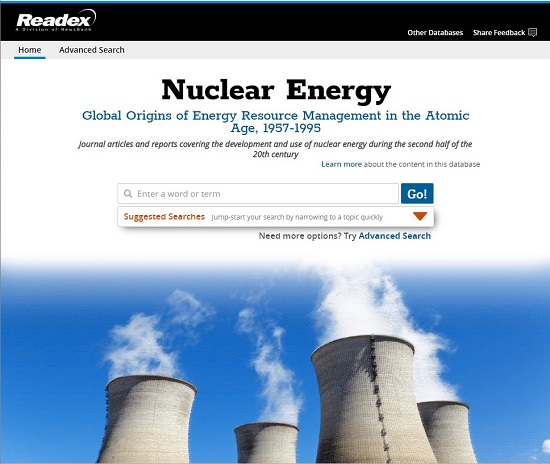“Not the sort of thing one forgets”: Using primary source documents to trace the effects of the Chernobyl nuclear disaster

On April 26, 1986, a safety experiment at the Chernobyl nuclear power plant in northern Ukraine went terribly awry, unleashing plumes of fire and invisible radioactive particles that rained down on surrounding towns and cities. Considered the worst nuclear accident in history, the Chernobyl disaster exposed millions of people to radiation and displaced some 200,000 people from their homes.
Yet coverage of the disaster by the Soviet government and state media was shockingly circumspect, focusing on the valiant efforts of workers rather than the devastation experienced by innocent people and animals. A July 1986 report from Pravda, the official newspaper of the USSR, for example, praised the “organized and precise work” of cleanup crews, adding that “many of the power station workers serving the power units are setting examples of courage [muzhestvo] and enthusiasm in their labor.”
In September, the Russian news agency TASS quoted a health official who claimed that “no new cases of acute radiation sickness following the Chernobyl nuclear power plant accident have been recorded,” and that the few dozen people still affected were receiving “good-level medical assistance.”
It was only after the USSR collapsed in 1991 that survivors began speaking out about their ongoing struggles; and that scientists, journalists and historians began truly documenting the disaster’s consequences on environmental and human health. As the official account of the disaster gave way to a more nuanced, human story, a U.S. government organization that became part of the CIA monitored, collected and translated into English hundreds of documents related to Chernobyl, including official government reports, newspaper articles, scientific papers, transcripts of television broadcasts, and more. Today, as scholarly interest in nuclear safety and the impact of nuclear accidents grows, these primary source documents are increasingly crucial to understanding the immediate and long-term effects of one of the worst accidents in human history.
Researchers interested in the dissemination of information in the wake of disasters, particularly by authoritarian governments, will also find striking differences in coverage from before and after the USSR fell. While USSR reports from the 1980s sought to reassure local and foreign populations alike that cleanup and medical care was taking place in an orderly, controlled fashion, the Ukrainian state newspaper Holos Ukrayiny reported in 1994 that “the situation” was still “deteriorating,” with “a considerable increase in the number of cases of thyroid gland cancer, especially among children, as well as various dysfunctions of the endocrine system,” and a growing “concern that medical and disease-prevention work among the people is not conducted properly and the implementation of the Chernobyl programs is not sufficiently financed.”
Independent European publications, too, reported that the effects of Chernobyl were far from contained. Contamination of reindeer meat and wild fish continued to impact indigenous Samis in Norway; radiation was purported to cause malignant tumors and congenital abnormalities in Bucharest; and in the United Kingdom, half a million sheep roaming the “remote hills and moors” were still believed to be contaminated with radiation as late as the mid-1990s.
Such reports are crucially important as researchers around the world continue to calculate the true toll of Chernobyl. The official claim is that 31 people died as a direct result of the disaster, but historians combing reports and hospital records now believe that number may be significantly higher. And researchers are just beginning to tease out the indirect impacts that affected thousands of additional people. Recent studies suggest that many whose lives were thrown into flux by the accident suffered ongoing mental health struggles, including major depression, anxiety and post‐traumatic stress disorder, and that people involved in cleanup eventually committed suicide at a higher rate than the general population. Among them was Valery Alekseyevich Legasov, a Russian chemist who was one of the first scientists on the scene and who hung himself in 1988. As the Moscow newspaper Trud later reported, Legasov’s investigation into the consequences of Chernobyl so devastated him emotionally that he “almost physically felt the gulf which existed between him and his environment.”
Even the heroes whose stoic work was praised by Soviet state media weren’t immune. In a 1986 interview with Izvestiya, firefighter Leonid Petrovich Telyatnikov reflected that Chernobyl wasn’t “the kind of thing one forgets.”
Thankfully, the diligent documentation and preservation of Telyatnikov and other survivors’ memories means that the lessons from Chernobyl will indeed be remembered for years to come—and plied by generations of researchers for new and relevant insights.
Nuclear Energy: Global Origins of Energy Resource Management in the Atomic Age is one of five unique digital collections in the new Origins of Modern Science and Technology family from Readex.












